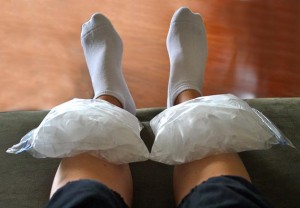Physio Health Advice > Shin Splints – What are they?
Shin Splints – what are they?
Also known as Medial Tibial Stress Syndrome (MTSS), this common injury usually affects runners, dancers and people who engage in sports that involve jumping and running. While shin splints can seem harmless, if left untreated they can really impact your ability to keep up training and even interfere with your daily routine. The good news is that you can prevent and treat shin splints quite easily.
Shin splints are a common overuse injury that causes pain along the inside of the tibia (shin bone). As with most overuse injuries it is caused by an inability of the structures around this region to cope with the demands of training. The pain can be coming from injury to the muscles surrounding the tibia, the structures that attach these muscles to the tibia or the tibia itself.
Signs and Symptoms
Shin splints often start as a dull pain around the inside of the shin, usually around the middle third of the lower leg.
You may feel pain before, during, or after activity. The affected area may be sore and tender, with some swelling and often both legs are affected. Pain often begins gradually and in the beginning it may come and go, however as the condition progresses pain can be present all the time.
How Does It Happen?
The exact cause of shin splints is often difficult to pinpoint, however as with many overuse injuries, dysfunction at another site can cause tissue to take on more stress and begin to breakdown. Below are some common factors that may increase your risk of developing shin splints.
• Training errors, increasing intensity too quickly.
• Pronating feet or uneven leg length.
• Running uphill or on hard surfaces.
• Unsupportive footwear.
• Gluteal weakness and pelvic instability.
• Reduced muscle strength and flexibility
How Can Physiotherapy Help?
As many other conditions can mimic shin splints so it is important to visit your physiotherapist who can diagnose your condition correctly and advise suitable reductions to your training program. Furthermore, left untreated, shin splints have been known to develop into stress fractures or compartment syndrome.
While rest and ice will help to settle symptoms quickly, your physiotherapist will be able to identify the factors most likely to be contributing to your pain and assist with correction of any muscle imbalances, joint stiffness or training errors.
For further treatment options and advice on managing your shin splints, don’t hesitate to ask your physiotherapist.
Click here to book an appointment.



